#agileprojectmanager
Explore tagged Tumblr posts
Text
Embracing Agile: Revolutionizing Project Management
In today's fast-paced business environment, adaptability and swift responses to change are crucial. The Agile methodology, originally developed for software development, has transcended its origins and become a transformative approach for various industries. Agile emphasizes iterative progress, collaboration, and flexibility, making it a powerhouse in modern project management. Here’s why adopting Agile can be a game-changer for your organization.
#Agile#Agileprojectmanagement#AgilePM#Agileprojectmanager#scrum#projectmetrics#dashboardmetrics#projectkpis#projectmanagementkpis#keyperformanceindicators#PMtrends#projectmanagertrends#projectmanagementtrends#futureprojects#PMcareers#Projectmanagement#PMO#ProjectManager#BusinessAnalyst#ProgrammeManager#Governance#ScrumMaster#Planning#Projecttemplates
1 note
·
View note
Text
Vabro: Your All-In-One Solution for Agile Product Development!
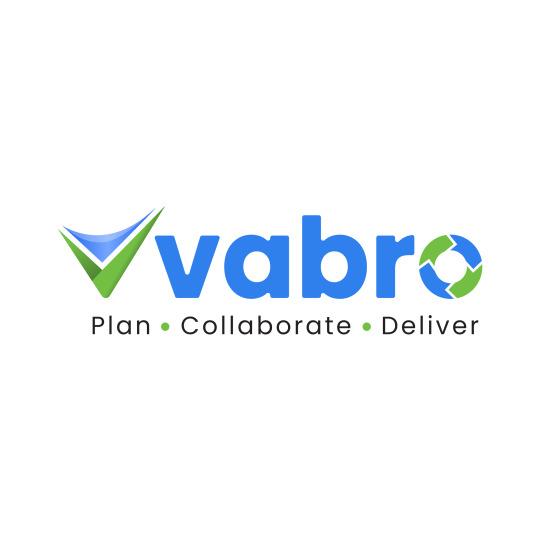
🚀🚀 Introducing Vabro: Your All-In-One Solution for Agile Product Development! Are you ready to take your project management to the next level? Meet Vabro, the ultimate platform designed to supercharge your Agile workflows and maximize team productivity. Here's a sneak peek into what Vabro has to offer: ✅ Seamless SCRUM Integration: Harness the power of the Scrum Framework with Vabro's intuitive features, enabling you to streamline project planning, execution, and delivery. ✅ Robust DevOps Collaboration: Embrace a culture of collaboration and continuous delivery with Vabro's seamless integration of DevOps principles, ensuring a smooth and efficient workflow for your teams. ✅ Customizable Agile Workflows: Tailor your project management experience with Vabro's customizable workflows, allowing you to adapt to the unique requirements of your projects and teams effortlessly. ✅ Real-Time Task Tracking: Stay on top of your tasks with Vabro's real-time tracking, enabling you to monitor progress, identify bottlenecks, and ensure timely project delivery. ✅ Enhanced Team Collaboration: Foster a culture of transparency and accountability with Vabro's collaborative tools, empowering your teams to work together seamlessly and achieve remarkable results. Join us on this exciting journey of elevating your project management experience. Visit www.vabro.com to learn more about Vabro and how it can transform the way your team works! Stay tuned for more insights and best practices on Scrum and Agile methodologies.
#Vabro#scrumstudy#AgileProjectManagement#AgileProductDevelopment#SCRUM#DevOps#TeamCollaboration#ProjectDelivery#ProductivityBoost
2 notes
·
View notes
Link
Tired of clunky project management processes? Discover Scrum, the Agile methodology that's transforming project management. Our latest blog explores its transformative power and how it's driving faster delivery, increased team productivity, and better outcomes. Ready to revolutionize your approach? Check out our blog now!
#development#project#mangement#projectmanagementtechniques#projectmanagementmethodoliges#projectmanagementtools#projectmanagementsoftware#team#projectmanagement#agileprojectmanagement#productivity#agile#scrum
3 notes
·
View notes
Text
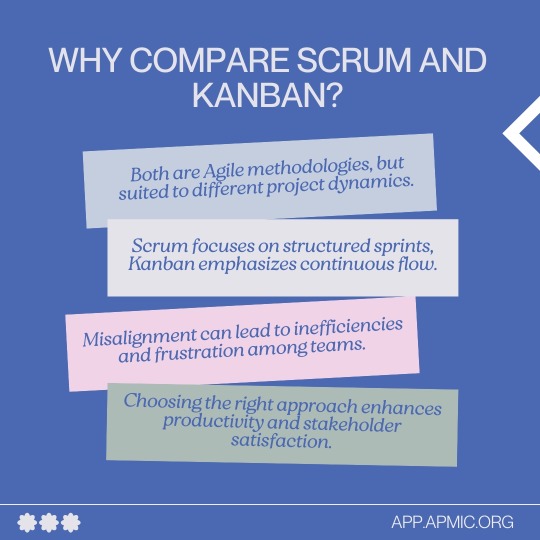
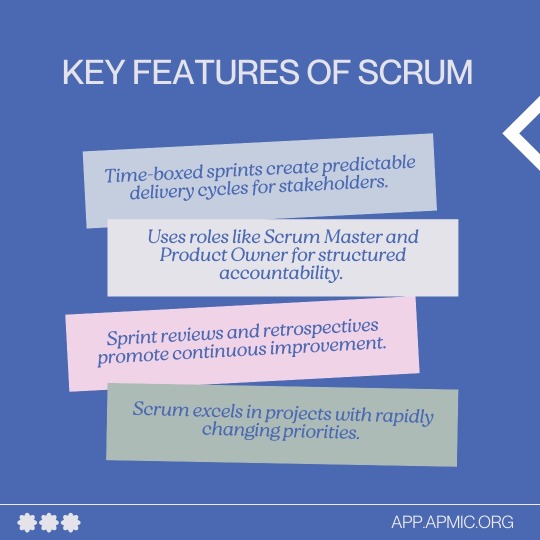
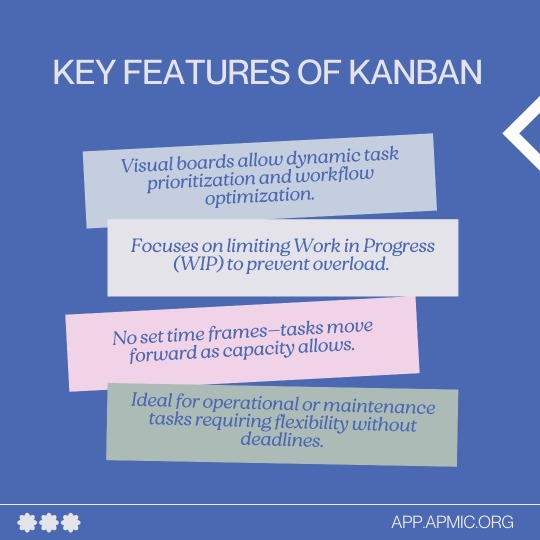


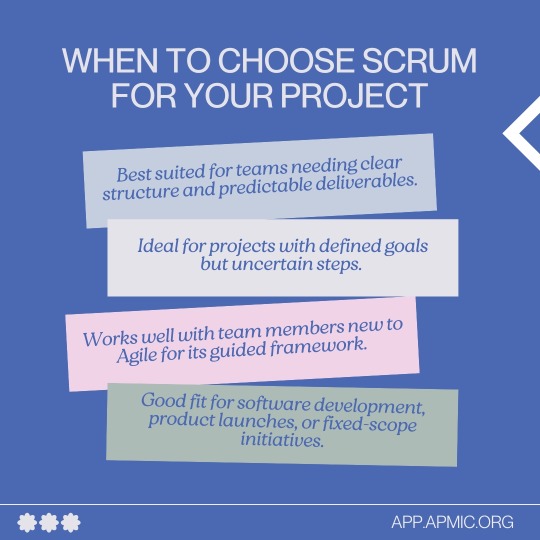
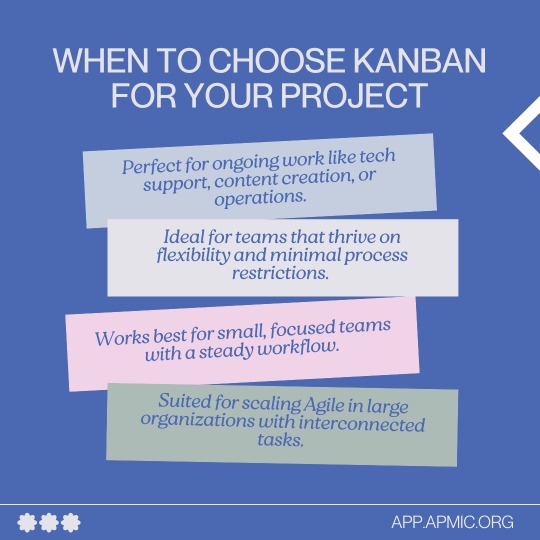

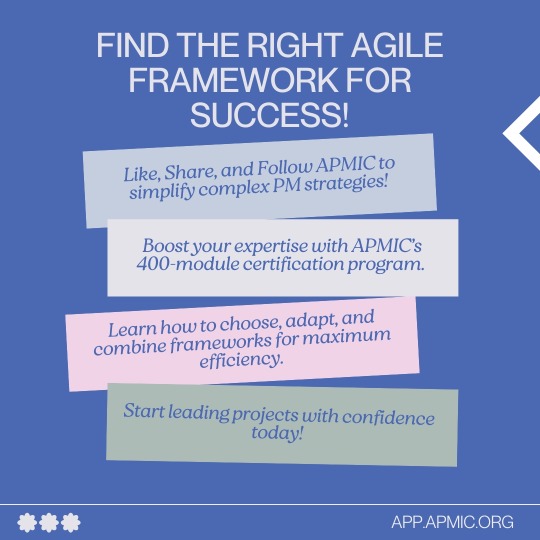

📌 Scrum vs. Kanban – Which One is Right for Your Next Project? 🚀
Both are Agile methodologies, but choosing the right one matters!
🔹 Scrum: Structured sprints, defined roles (Scrum Master, Product Owner), and predictable delivery cycles. Best for projects with evolving priorities.
🔹 Kanban: Continuous workflow, WIP limits, and no fixed time frames. Ideal for operational tasks needing flexibility.
✅ Scrum is best for: Software development, product launches, and structured teams. ✅ Kanban is best for: Ongoing work like tech support, content creation, and operations.
🔄 Hybrid Approach? Try Scrumban! Combine Kanban’s flexibility with Scrum’s sprint discipline.
📥 Follow @apmicorg for expert Agile insights!
#scrumvskanban #agileprojectmanagement #scrummaster #kanbanboard #agilemethodology #sprintplanning #leanagile #projectmanagement #scrumcoach #agileworkflow #techleadership #teamefficiency #scrumdaily #kanbansystem #projectsuccess #scrumalliance #agiletransformation #businessagility #scrumtraining #APMIC
#scrumvskanban#agileprojectmanagement#scrummaster#kanbanboard#agilemethodology#sprintplanning#leanagile#projectmanagement#scrumcoach#agileworkflow#techleadership#teamefficiency#scrumdaily#kanbansystem#projectsuccess#scrumalliance#agiletransformation#businessagility#scrumtraining#APMIC
0 notes
Text
🌟 Advance Your Agile Career with PMI-ACP Certification Training at Learnovative! 🌟
Looking to validate your Agile expertise? Join Learnovative's PMI-ACP Certification Training and become a certified Agile professional! This course is perfect for those who want to deepen their understanding of Agile practices and methodologies.
✨ Why Choose Learnovative for PMI-ACP?
🔹 Expert instructors with extensive Agile experience
🔹 Comprehensive curriculum covering Agile tools and techniques
🔹 Hands-on learning with real-world case studies
🔹 Globally recognized certification to boost your career
🚀 Don’t miss this opportunity to excel in Agile project management. Let’s build your future together!
Call now : 09949994949
#Learnovative#PMIACP#AgileProjectManagement#AgileCertification#ProfessionalGrowth#AgileTraining#CSM#CSPO#ACSM#ACSPO#CSMtraininginHyderabad#CSMtrainingcoursesinHyderabad#ScrumMastertraininginHyderabad#ScrumMastercertificationinHyderabad#CertifiedScrumMastercertificationinHyderabad#CertifiedScrumMastercertificationtraininginHyderabad#CSMcertificationinHyderabad#CertifiedScrumTrainerinHyderabad#CertifiedAgileScrumTrainerinHyderabad#CertifiedEnterpriseCoachinHyderabad#CertifiedTeamCoachforCSMinHyderabad#CertifiedTeamCoach#CSPOinHyderabad
0 notes
Text
#ProjectManagement#PMP#PMPCertification#ProjectManager#AgileProjectManagement#ProfessionalCertification#CareerGrowth#SkillDevelopment#Upskilling#PMO#ScrumMaster#RiskManagement#BusinessStrategy
1 note
·
View note
Text
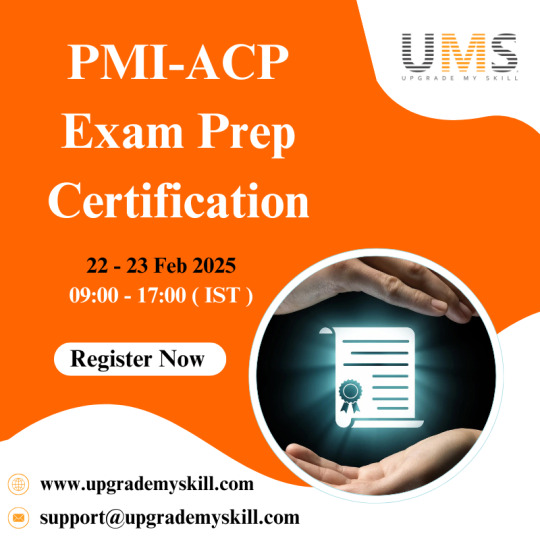
🚀 Achieve PMI-ACP® Certification and Lead Agile Transformations!
In today’s dynamic business world, Agile Project Management is key to delivering high-value, client-focused results at speed. 📈 Upgrade My Skill offers a comprehensive PMI-ACP Exam Prep Certification Training to equip you with the expertise to: ✅ Master Agile frameworks like Scrum, Kanban, Lean, XP, and TDD ✅ Manage complex projects confidently in fast-paced environments ✅ Lead Agile transformations and deliver exceptional results
💡 This 21-contact-hour program combines interactive workshops, case studies, and mock exams for real-world readiness.
Whether you're an experienced project manager or transitioning into Agile, this certification unlocks leadership opportunities across IT, healthcare, finance, and more.
📅 Flexible learning options: Classroom & Live Online Training!
🌟 Enroll Now to advance your career in Agile Project Management! : https://www.upgrademyskill.com/pmi-acp-exam-prep-certification-training
#PMIACP#AgileProjectManagement#PMIACPCertification#UpgradeMySkill#AgileTransformation#Scrum#Kanban#Lean#TDD#ProjectManagement#AgileLeadership#CertificationTraining#ProfessionalGrowth#careerdevelopment
1 note
·
View note
Text
#ProjectPortfolioManagement#PPM#ProjectManagement#PortfolioManagement#BusinessSolutions#ProjectManagementSoftware#WorkforceOptimization#PMO#ProjectPlanning#EnterpriseSoftware#ProjectExecution#RiskManagement#AgileProjectManagement#ProjectEfficiency#ProjectSuccess#ProjectTracking#DigitalTransformation#ProjectManagementTools#PortfolioOptimization#BusinessGrowth#ResourceManagement
0 notes
Text

7 Anti-Pattern Umum dalam Scrum: Sebuah Analisis
Scrum, sebagai salah satu kerangka kerja Agile yang populer, memberikan struktur bagi tim untuk menghasilkan nilai secara iteratif dan inkremental. Namun, meskipun memiliki keunggulan, sering kali tim terjebak dalam anti-pattern, yaitu kebiasaan atau praktik yang terlihat bermanfaat tetapi justru merusak prinsip dasar Scrum. Visual yang diberikan menggambarkan tujuh anti-pattern umum dalam Scrum, yang menunjukkan kesalahpahaman terhadap peran, ritual, dan tujuan Scrum. Berikut adalah analisis setiap anti-pattern beserta dampaknya terhadap efektivitas Scrum:
1. Scrum Master sebagai Project Manager
Salah satu anti-pattern yang paling sering terjadi adalah memperlakukan Scrum Master seperti Project Manager tradisional. Pemahaman ini bertentangan dengan inti peran Scrum Master, yaitu sebagai fasilitator, pelatih, dan penjaga praktik Scrum. Ketika Scrum Master mengambil alih tugas manajemen proyek, seperti pembagian tugas dan penegakan tenggat waktu, hal ini merampas otonomi tim dan merusak prinsip self-organizing dalam Scrum.
2. Scrum Goals sebagai Project Mister
Anti-pattern ini menggambarkan penyalahgunaan sprint goals sebagai deliverable proyek yang kaku. Alih-alih menjadi tujuan yang memberikan makna, sprint goals sering kali direduksi menjadi sekadar daftar tugas tanpa konteks. Padahal, sprint goals seharusnya mencerminkan nilai yang ingin dicapai tim, bukan hanya daftar hasil keluaran. Ketika tujuan tidak selaras dengan visi yang lebih besar, fokus tim dalam memberikan nilai kepada pemangku kepentingan menjadi kabur.
3. Three Sprint Goals sebagai Wish List
Membebani sprint dengan terlalu banyak tujuan mengaburkan fokus dan prioritas tim. Anti-pattern ini mencerminkan kurangnya pemahaman akan pentingnya menetapkan tujuan yang ringkas dan dapat dicapai untuk membimbing tim. Pendekatan seperti “wish list” melemahkan kejelasan sprint, yang pada akhirnya menyebabkan pekerjaan tidak selesai dan menimbulkan rasa frustrasi dalam tim.
4. Sprint Goals sebagai Wish List
Mirip dengan anti-pattern sebelumnya, ini terjadi ketika sprint goals ditetapkan secara tidak realistis atau terlalu abstrak. Sprint goals bertujuan memberikan arahan dan nilai yang dapat diukur. Ketika tujuan hanya bersifat aspiratif alih-alih dapat dieksekusi, tim kehilangan kriteria keberhasilan yang jelas, sehingga retrospektif menjadi tidak efektif dan upaya perbaikan berkelanjutan terhambat.
5. Daily Standup sebagai Swish List
Daily standups adalah elemen penting dalam Scrum, dirancang untuk meningkatkan keselarasan tim dan mengidentifikasi hambatan. Namun, anti-pattern ini muncul ketika standup berubah menjadi daftar keinginan atau laporan status, sehingga kehilangan fokus utamanya untuk menyelesaikan masalah. Standup yang efektif harus singkat, kolaboratif, dan berpusat pada tiga pertanyaan inti: Apa yang dikerjakan kemarin? Apa yang akan dikerjakan hari ini? Hambatan apa yang ada?
6. Daily Standup sebagai Status Debt
Dalam anti-pattern ini, daily standup hanya menjadi ritual formal tanpa diskusi bermakna. Anggota tim mungkin hanya melaporkan progres tanpa membahas kendala atau mencari solusi. Pendekatan yang dangkal seperti ini menghasilkan status debt, di mana masalah yang tidak terselesaikan terus menumpuk, menghambat progres sprint secara keseluruhan.
7. Technical Debt sebagai Irnositechnal Debt
Anti-pattern terakhir ini menyoroti kegagalan dalam mengelola technical debt, yaitu akumulasi kompromi teknis dalam desain atau kode yang menghambat pengembangan di masa depan. Mengabaikan atau salah mengelola technical debt merusak skalabilitas, performa, dan maintainability produk. Tim Scrum harus secara aktif memasukkan resolusi technical debt ke dalam backlog untuk memastikan kesehatan produk dalam jangka panjang.
Kesimpulan
Anti-pattern ini menekankan pentingnya memahami dan menjalankan prinsip Scrum dengan benar. Tim harus ingat bahwa Scrum lebih dari sekadar serangkaian proses; ini adalah sebuah pola pikir yang mengutamakan kolaborasi, pemberian nilai, dan perbaikan berkelanjutan. Dengan mengenali dan mengatasi anti-pattern, tim dapat kembali selaras dengan nilai inti Scrum dan memaksimalkan potensinya. Praktik Scrum yang efektif membutuhkan kewaspadaan, disiplin, dan komitmen untuk membangun budaya kepercayaan dan transparansi.
0 notes
Text
Prioritizing project risks is a cornerstone of successful project management. By systematically evaluating likelihood, impact, and proximity and involving stakeholders in the process you can focus on the most critical challenges, safeguard your project’s success, and use resources effectively.
#ProjectManagement#RiskManagement#RiskPrioritization#BusinessStrategy#ProjectPlanning#MitigationStrategies#StakeholderEngagement#RiskAssessment#PMTools#DecisionMaking#SWOTAnalysis#RiskMatrix#TeamCollaboration#AgileProjectManagement#LeadershipSkills
0 notes
Text

Product Owner vs. Scrum Master: The Two Pillars who support the Team! In the dynamic world of Scrum, understanding the distinct roles of a Product Owner and a Scrum Master is crucial for project success! 🚀 👨💼 Product Owner: The Visionary Leader As the visionary leader, the Product Owner defines the project's vision, sets priorities, and ensures the team works on the most valuable features. With Vabro, Product Owners can easily manage the backlog, prioritize user stories, and collaborate with stakeholders for seamless project alignment. 🛠️ Scrum Master: The Facilitator & Coach The Scrum Master serves as the team's coach, ensuring adherence to Scrum principles and practices. They facilitate meetings, remove impediments, and foster a collaborative environment. With Vabro, Scrum Masters can facilitate sprint planning, daily stand-ups, and retrospectives, driving continuous improvement and team efficiency. In Vabro, these roles synergize to drive Agile success, empowering teams to deliver exceptional results!
💡 To know more, please visit - www.vabro.com.
#Agile#Scrum#ProductOwner#ScrumMaster#Vabro#csm#psm#scrumalliance#scrumstudy#scrumframework#agileprojectmanagement#scrumtool
2 notes
·
View notes
Text
Agile Project Management is an iterative, flexible approach focused on collaboration and continuous delivery. It adapts to change.
Work is split into "sprints," enabling frequent feedback and improvements to meet customer needs. Check the article for more details.
0 notes
Text
ChatGPT Prompts for Project Managers
#ChatGPTPromptsForProjectManagers#ProjectManagement#PMTools#AgileProjectManagement#Scrum#ProjectPlanning#RiskManagement#StakeholderManagement#TeamLeadership#ProjectScheduling#ResourceAllocation#ProjectExecution#ProjectMonitoring#PMBestPractices#ProjectDelivery#TaskManagement#PMMethodologies#ProjectLifecycle#ChatGPT#PromptEngineering#Prompt
0 notes
Text
Transform Your Organization with SAFe® Agilist Leadership Skills

Master Lean-Agile Leadership with SAE Agilist Certification
In today's fast-paced business environment, aligning agile practices across the enterprise is crucial for sustained success. The SAFE Agilist Certification empowers leaders, managers, and executives with the knowledge and skills to drive a Lean-Agile transformation within their organization. Ievision’s SAFe® Agilist Project Management Course is designed to help professionals adopt agile practices across teams, departments, and even entire companies.
Why Choose the SAFe® Agilist Certification?
SAFe® (Scaled Agile Framework) is a widely adopted approach for scaling agile practices beyond small teams. As a SAFE Agilist, you’ll learn to:
Lead Lean-Agile transformation: Drive enterprise-wide change and foster a culture of collaboration and continuous improvement.
Align teams with business objectives: Coordinate multiple agile teams to work towards common goals, ensuring that business strategy aligns with execution.
Implement Lean Portfolio Management: Streamline portfolio-level decision-making to enhance value delivery.
Maximize product development flow: Identify and remove obstacles to accelerate product delivery, reduce waste, and improve efficiency.
Course Highlights
Comprehensive SAFe® Framework Overview: Gain in-depth knowledge of how SAFe® applies to both small projects and large-scale initiatives.
Lean-Agile Mindset: Cultivate a leadership mindset based on lean thinking and agile principles.
Collaboration & Cross-functional Teams: Foster collaboration across teams, departments, and the organization.
Effective Execution: Learn to apply SAFE principles to achieve reliable and predictable outcomes.
Implementing Agile Release Trains (ARTs): Understand how to create value streams and ensure efficient, coordinated delivery.
Who Should Attend?
Executives & Leaders are looking to transform their business with Lean-Agile practices.
Project Managers aiming to scale agile across multiple teams and portfolios.
Product Managers, Engineers, and Developers want to understand SAFE principles for product development and delivery.
Agile Coaches & Consultants seeking to implement and teach SAFE methodologies.
Certification & Benefits
Upon successful completion of the course and exam, you will earn the SAFe® Agilist Certification, recognized globally. This credential enables you to:
Lead large-scale agile projects across multiple teams.
Implement SAFE principles to enhance organizational performance.
Elevate your career by gaining expertise in scaling agile practices.
Elevate Your Agile Leadership with Ievision
At Ievision, we are committed to offering top-tier training that empowers professionals to excel in agile project management. With expert instructors, real-world case studies, and a curriculum aligned with industry standards, our SAFE Agilist course is your gateway to mastering Lean-Agile leadership.
#SAFeAgilist#LeanAgileLeadership#AgileTransformation#ScaledAgileFramework#AgileProjectManagement#AgileLeadership#EnterpriseAgility#SAFeCertification#AgileTraining#LeanAgileMindset
0 notes
Text

Streamline your agile project management with Zoho Sprints! This tool helps you plan, track, and manage your projects efficiently using agile methodologies. From sprint planning to task management and progress tracking, Zoho Sprints ensures your team stays on top of their game and delivers results faster. Explore how Zoho Sprints can boost your project efficiency and team collaboration!
#ZohoSprints#AgileProjectManagement#SprintPlanning#ProjectTracking#TeamCollaboration#AgileTools#ZohoApps#ProjectManagement#Efficiency#Workflows#Scrum#Productivity#Zoho
0 notes